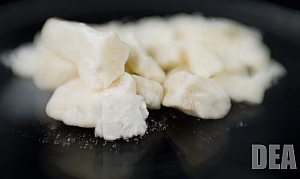Medical researchers at Weill Cornell Medical College in New York tested in primates a vaccine candidate against cocaine addiction, which showed the vaccine prevented cocaine from reaching the brain and inducing a dopamine high. The findings from the team led by genetic medical researcher Ronald Crystal, with colleagues from Weill Cornell, Columbia University, and Scripps Research Institute appear online today in the journal Neuropsychopharmacology (paid subscription required).
The university says its technology transfer office filed a patent on the process developed by the researchers, with Crystal listed as a co-inventor.
Cocaine addiction results from the body becoming dependent on the neurotransmitter dopamine that affects the pleasure centers of the brain, notably in the putamen in the forebrain that works with the caudate nucleus in the center of the brain. The putamen and caudate nucleus use dopamine to perform their functions, generally the regulation of movements and some types of learning.
Crystal explains that cocaine causes an accumulation of dopamine on nerve endings in the brain, however, resulting in a flood of dopamine that generates the pleasurable chemical high. The vaccine candidate developed by Crystal’s team combines elements of a common cold virus with particles of a substance resembling the chemistry of cocaine. This combination induces the generation of antibodies to the cold virus, while at the same time building defenses against the cocaine substitute.
In earlier preclinical studies, the researchers injected lab mice with the vaccine combination, and found the mice generated a strong immune reaction. The antibodies produced by and taken from the mice also consumed cocaine in test tubes. When vaccinated mice were given cocaine, they appeared less hyperactive than unvaccinated mice.
The new study extended the tests to non-human primates that are closer in evolutionary biology to humans. For this study, Crystal and colleagues devised a monitoring technique to measure the dopamine transported to the brain. Cocaine binds to the transporter mechanism, preventing the dopamine from cycling out of the brain, and causing a build up of dopamine and the subsequent chemical high. The monitoring technique attaches a radio-isotope tracer to the dopamine transporter, which lets the dopamine be followed and measured during positron emission tomography or PET scanning.
The study measured the difference in the dopamine binding, as indicated by the tracer in PET scans, between vaccinated and unvaccinated primates, both with and without cocaine. The results showed a large difference in tracer amounts between vaccinated and unvaccinated primates when cocaine was introduced. In the unvaccinated animals, the cocaine replaced the isotope tracer that bound to the dopamine transporter. In vaccinated animals, however, tracer activity more closely resembled the level of primates not given cocaine.
The researchers cited studies in humans of cocaine displacement in dopamine transporters that show nearly half (47%) of the dopamine transporter must be occupied by cocaine to produce the chemical high. Crystal and colleagues report that in vaccinated primates, cocaine in the brain’s dopamine receptors did not reach 20 percent.
A number of key questions still remain before the cocaine vaccine can be tested on humans. Among the questions is the enduring effect of the vaccine, which lasted 13 weeks for mice and 7 weeks in non-human primates.
Read more:
- Lozenges, Tobacco-Free Snuff Help Tobacco Chewers Quit
- $2.25M Challenge Seeks Health Care Sensing Technologies
- NIH Grant Awarded for Smoking Relapse Prevention Drug
- NIH Grant to Fund R&D on Pain Meds With Fewer Side Effects
* * *


 RSS - Posts
RSS - Posts
You must be logged in to post a comment.